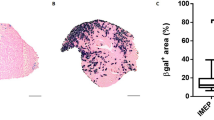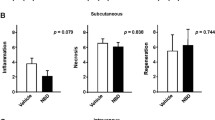Abstract
A retrospective study in which we reviewed the hospital files of a subset of 7 patients with Duchenne muscular dystrophy participating in the open-label phase I/II PRO051-02 study in Leuven. The objective of this study was to describe in detail the injection site reactions in these children treated with drisapersen (PRO-051), a 2′-O-methyl phosphorothioate RNA antisense oligonucleotide, that induces exon 51 skipping in Duchenne muscular dystrophy. Antisense oligonucleotides, restoring the reading frame by skipping of exons, have become a potential treatment of Duchenne muscular dystrophy and other monogenetic diseases. Erythema followed by hyperpigmentation, fibrosis, and calcification were seen at the injection sites in all children. Ulcerations, which were difficult to heal, occurred in 5 of 7 children. Progression still occurred after switching to intravenous administration of drisapersen or even after stopping therapy. Systemic reactions included a reversible proteinuria and α1-microglobulinuria. Moreover, hypotrichosis was a common feature.
Conclusion: Subcutaneous administration of drisapersen causes severe and progressive injection site effects.
What is known: • Antisense oligonucleotides offer the possibility to convert Duchenne muscular dystrophy to the less severe Becker type. This can potentially be achieved by targeting and skipping specific exons of the Duchenne muscular dystrophy gene to restore the disrupted reading frame and to induce the production of a semi functional dystrophin protein. • Drisapersen is such an antisense oligonucleotides which can be administered subcutaneously. Its use has been tested extensively in the escalating dose pilot study (PRO051-02). | |
What is new: • This report describes the injection site reactions caused by this type of agent in detail which has never been done before. We therefore reviewed the hospital files of 7 patients with Duchenne muscular dystrophy participating in the phase I/II open-label, escalating dose pilot study (PRO051-02) with drisapersen. • Severe side effects starting with erythema, hyperpigmentation, and later fibrosis, calcification, and difficult to treat ulcerations developed in all patients, and these continued to progress even after cessation of drisapersen. We discuss some possible underlying mechanisms. The exact mechanism however is still not known. |


Similar content being viewed by others
Abbreviations
- 2OMePS:
-
2′-O-methyl phosphorothioate
- AON:
-
Antisense oligonucleotide
- DMD:
-
Duchenne muscular dystrophy
- ISR:
-
Injection site reactions
- LNA-PS:
-
Locked nucleic acid-phosphorothioate
- MOE-PS:
-
Methoxyethyl-phosphorothioate
- PS:
-
Phosphorothioate
References
Aartsma-Rus A, De Winter CL, Janson AA, Kaman WE, van Ommen GJ, den Dunnen JT, van Deutekom JC (2005) Functional analysis of 114 exon-internal AONs for targeted DMD exon skipping: indication for steric hindrance of SR protein binding sites. Oligonucleotides 15:284–297. https://doi.org/10.1089/oli.2005.15.284
Aartsma-Rus A, Fokkema I, Verschuuren J, Ginjaar I, van Deutekom J, van Ommen GJ, den Dunnen JT (2009) Theoretic applicability of antisense-mediated exon skipping for Duchenne muscular dystrophy mutations. Hum Mutat 30:293–299. https://doi.org/10.1002/humu.20918
Aartsma-Rus A, Houlleberghs H, van Deutekom JC, van Ommen GJ, ‘t Hoen PA (2010) Exonic sequences provide better targets for antisense oligonucleotides than splice site sequences in the modulation of Duchenne muscular dystrophy splicing. Oligonucleotides 20:69–77. https://doi.org/10.1089/oli.2009.0215
Arechavala-Gomeza V, Graham IR, Popplewell LJ et al (2007) Comparative analysis of antisense oligonucleotide sequences for targeted skipping of exon 51 during dystrophin pre-mRNA splicing in human muscle. Hum Gene Ther 18:798–810. https://doi.org/10.1089/hum.2006.061
Bladen CL, Salgado D, Monges S et al (2015) The TREAT-NMD DMD Global Database: analysis of more than 7,000 Duchenne muscular dystrophy mutations. Hum Mutat 36:395–402. https://doi.org/10.1002/humu.22758
Domingos J, Ricotti V, Martinez AE, Muntoni F (2018) Severe persistent injection site reactions after subcutaneous 2-O-methylphosphorothioate oligonucleotide therapy for Duchenne muscular dystrophy. Neuromuscul Disord 28:176–177. https://doi.org/10.1016/j.nmd.2017.11.015
Goemans NM, Tulinius M, van den Akker JT et al (2011) Systemic administration of PRO051 in Duchenne’s muscular dystrophy. N Engl J Med 364:1513–1522. https://doi.org/10.1056/NEJMoa1011367
Goemans NM, Tulinius M, van den Hauwe M, Kroksmark AK, Buyse G, Wilson RJ, van Deutekom JC, de Kimpe SJ, Lourbakos A, Campion G (2016) Long-term efficacy, safety, and pharmacokinetics of drisapersen in duchenne muscular dystrophy: results from an open-label extension study. PLoS One 11:e0161955. https://doi.org/10.1371/journal.pone.0161955
Guiraud S, Aartsma-Rus A, Vieira NM, Davies KE, van Ommen GJ, Kunkel LM (2015) The pathogenesis and therapy of muscular dystrophies. Annu Rev Genomics Hum Genet 16:281–308. https://doi.org/10.1146/annurev-genom-090314-025003
Magri F, Govoni A, D’Angelo MG et al (2011) Genotype and phenotype characterization in a large dystrophinopathic cohort with extended follow-up. J Neurol 258:1610–1623. https://doi.org/10.1007/s00415-011-5979-z
Muntoni F, Wood MJ (2011) Targeting RNA to treat neuromuscular disease. Nat Rev Drug Discov 10:621–637. https://doi.org/10.1038/nrd3459
Robbins M, Judge A, Liang L, McClintock K, Yaworski E, MacLachlan I (2007) 2’-O-methyl-modified RNAs act as TLR7 antagonists. Mol Ther 15:1663–1669. https://doi.org/10.1038/sj.mt.6300240
Van Deutekom JC (2005) Gene therapy: the ‘pro-sense’ approach to Duchenne muscular dystrophy. Eur J Hum Genet 13:518–519. https://doi.org/10.1038/sj.ejhg.5201381
Van Deutekom JC, Janson AA, Ginjaar IB et al (2007) Local dystrophin restoration with antisense oligonucleotide PRO051. N Engl J Med 357:2677–2686. https://doi.org/10.1056/NEJMoa073108
Van Meer L, Moerland M, Gallagher J, van Doom MB, Prens EP, Cohen AF, Rissmann R, Burggraaf J (2016) Injection site reactions after subcutaneous oligonucleotide therapy. Br J Clin Pharmacol 82:340–351. https://doi.org/10.1111/bcp.12961
Van Putten M, Young C, van den Berg S, Pronk A, Hulsker M, Karnaoukh TG, Vermue R, van Dijk KW, de Kimpe S, Aartsma-Rus A (2014) Preclinical studies on intestinal administration of antisense oligonucleotides as a model for oral delivery for treatment of duchenne muscular dystrophy. Mol Ther Nucleic Acids 3:e211. https://doi.org/10.1038/mtna.2014.62
Voit T, Topaloglu H, Straub V et al (2014) Safety and efficacy of drisapersen for the treatment of Duchenne muscular dystrophy (DEMAND II): an exploratory, randomised, placebo-controlled phase 2 study. Lancet Neurol 13:987–996. https://doi.org/10.1016/S1474-4422(14)70195-4
Yu C, An M, Li M, Liu H (2017) Immunostimulatory properties of lipid modified CpG oligonucleotides. Mol Pharm 14:2815–2823. https://doi.org/10.1021/acs.molpharmaceut.7b00335
Acknowledgments
We thank Petra De Haes for comments that greatly improved the manuscript. We would also like to thank the BioMarin Pharmaceutical Inc. for disclosing all information regarding drisapersen.
Portions of this study have been presented at the annual European Society for Pediatric Dermatology (ESPD) congress in Palma de Mallorca on October the 21st 2017.
Author information
Authors and Affiliations
Contributions
N.H. (leading author), N.G. and MA.M. (senior author) collected and analyzed the data. N.H. and MA.M drafted the manuscript and designed the figures. N.G. contributed to the writing of the manuscript. I.S. analyzed portions of the data and made corrections in the tables of the final version. All authors revised the final version of the article before submitting it.
Corresponding author
Ethics declarations
Conflict of interest
Nathalie Goemans was principle investigator for PRO051. However, no potential conflicts of interest were reported by the authors.
Informed consent
All subjects have given their consent to use their data from the PRO051 study for further research and articles.
Additional information
Communicated by Mario Bianchetti
Electronic supplementary material
Supplementary Table 1
(DOCX 31 kb)
Rights and permissions
About this article
Cite this article
Hilhorst, N., Spanoudi-Kitrimi, I., Goemans, N. et al. Injection site reactions after long-term subcutaneous delivery of drisapersen: a retrospective study. Eur J Pediatr 178, 253–258 (2019). https://doi.org/10.1007/s00431-018-3272-1
Received:
Revised:
Accepted:
Published:
Issue Date:
DOI: https://doi.org/10.1007/s00431-018-3272-1




